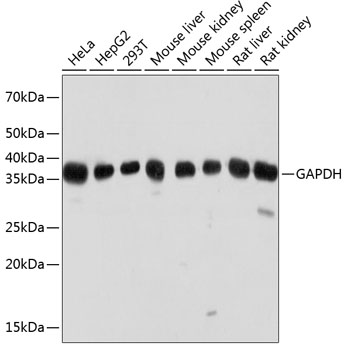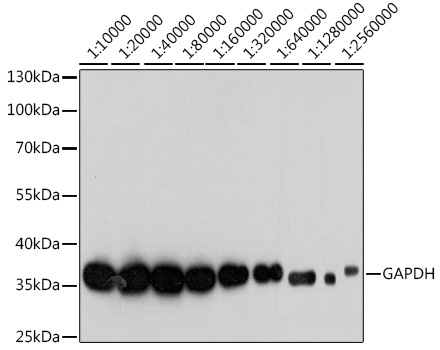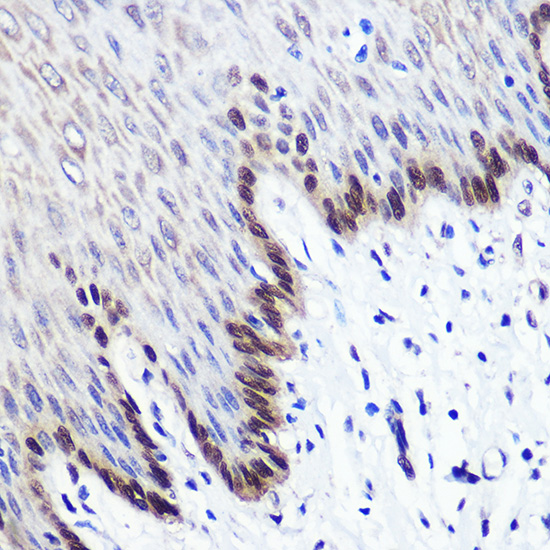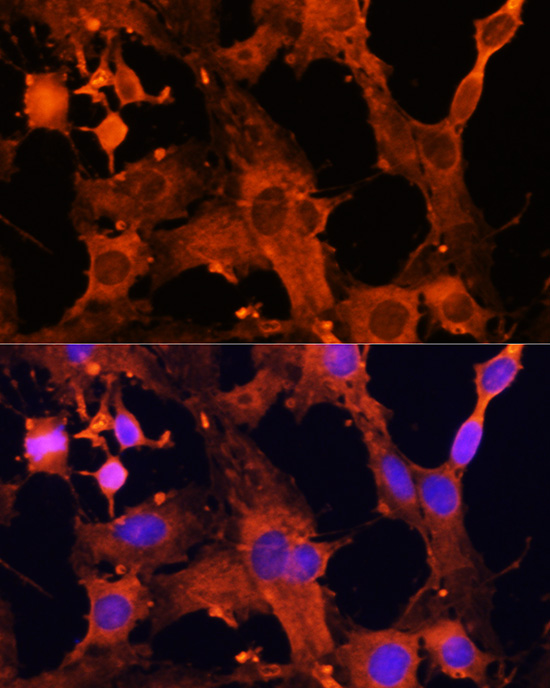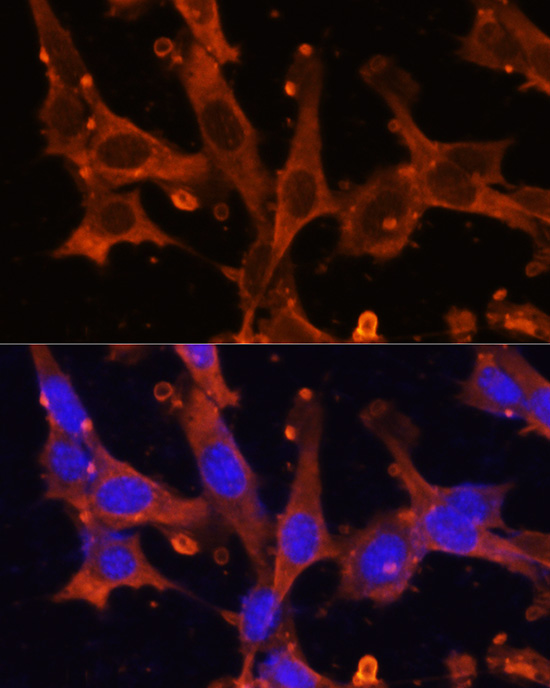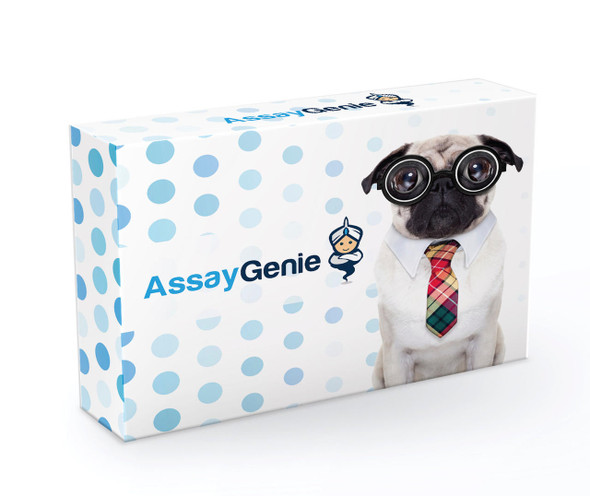Cell Death Antibodies 2
Anti-GAPDH Antibody (High Dilution) (CABC033)
- SKU:
- CABC033
- Product Type:
- Antibody
- Reactivity:
- Human
- Reactivity:
- Mouse
- Reactivity:
- Rat
- Host Species:
- Mouse
- Isotype:
- IgG
- Antibody Type:
- Monoclonal Antibody
- Research Area:
- Cell Death
Description
| Antibody Name: | Anti-GAPDH Antibody (High Dilution) |
| Antibody SKU: | CABC033 |
| Antibody Size: | 100 uL |
| Application: | WB IHC IF |
| Reactivity: | Human, Mouse, Rat |
| Host Species: | Mouse |
| Immunogen: | Recombinant protein of human GAPDH |
| Application: | WB IHC IF |
| Recommended Dilution: | WB 1:50000 - 1:200000 IHC 1:50 - 1:200 IF 1:50 - 1:200 |
| Reactivity: | Human, Mouse, Rat |
| Positive Samples: | HeLa, HepG2, 293T, Mouse liver, Mouse kidney, Mouse spleen, Rat liver, Rat kidney |
| Immunogen: | Recombinant protein of human GAPDH |
| Purification Method: | Affinity purification |
| Storage Buffer: | Store at -20°C. Avoid freeze / thaw cycles. Buffer: PBS with 0.02% sodium azide, 50% glycerol, pH7.3. |
| Isotype: | IgG |
| Sequence: | Email for sequence |
| Gene ID: | 2597 |
| Uniprot: | P04406 |
| Cellular Location: | Cytoplasm, Membrane, Nucleus, cytoskeleton, cytosol, perinuclear region |
| Calculated MW: | 31kDa/36kDa |
| Observed MW: | 36KDa |
| Synonyms: | G3PD, GAPD, HEL-S-162eP, GAPDH |
| Background: | This gene encodes a member of the glyceraldehyde-3-phosphate dehydrogenase protein family. The encoded protein has been identified as a moonlighting protein based on its ability to perform mechanistically distinct functions. The product of this gene catalyzes an important energy-yielding step in carbohydrate metabolism, the reversible oxidative phosphorylation of glyceraldehyde-3-phosphate in the presence of inorganic phosphate and nicotinamide adenine dinucleotide (NAD). The encoded protein has additionally been identified to have uracil DNA glycosylase activity in the nucleus. Also, this protein contains a peptide that has antimicrobial activity against E. coli, P. aeruginosa, and C. albicans. Studies of a similar protein in mouse have assigned a variety of additional functions including nitrosylation of nuclear proteins, the regulation of mRNA stability, and acting as a transferrin receptor on the cell surface of macrophage. Many pseudogenes similar to this locus are present in the human genome. Alternative splicing results in multiple transcript variants. Note?Dilution methodPut 5ul AC033 into 45 ul buffer(with 50% glycerol), diluted 1:10, 000 for using. The diluted antibody can be stored at -20'C without aliquot. |
| UniProt Protein Function: | GAPDH: a multifunctional enzyme with both glyceraldehyde-3-phosphate dehydrogenase and nitrosylase activities. A key glycolytic enzyme that catalyzes the first step of the pathway by converting D-glyceraldehyde 3-phosphate (G3P) into 3-phospho-D-glyceroyl phosphate. An important enzyme for energy metabolism, and the production of ATP and pyruvate through anaerobic glycolysis in the cytoplasm. Additionally, it participates in apoptosis, membrane trafficking, iron metabolism, nuclear activities and receptor mediated cell signaling. Its subcellular localization changes reflecting its multiple activities. Is cytosolic, but is also localized in the membrane, the nucleus, polysomes, the ER and the Golgi. Participates in transcription, RNA transport, DNA replication and apoptosis. S-nitrosylation on Cys-152 following apoptotic stimulates its interaction with SIAH2, which in turn moderates its translocation into the nucleus. Mediates cysteine S-nitrosylation of nuclear target proteins including SIRT1, HDAC2 and DNA-PK. Deregulated in lung cancer, renal cancer, breast cancer, gastric cancer, glioma, liver cancer, colorectal cancer, melanoma, prostatic cancer, pancreatic cancer and bladder cancer. Its increased expression and enzymatic activity is associated with cell proliferation and tumorigenesis, Oxidative stress impairs GAPDH catalytic activity and leads to cellular aging and apoptosis. In experimental animal models, injection of GAPDH antagonists induces apoptosis and blocks Hep3B tumor progression, suggesting a therapeutic potential of targeting GAPDH in human hepatocellular carcinoma |
| UniProt Protein Details: | Protein type:Oxidoreductase; EC 1.2.1.12; Carbohydrate Metabolism - glycolysis and gluconeogenesis Chromosomal Location of Human Ortholog: 12p13 Cellular Component: microtubule cytoskeleton; nuclear membrane; membrane; intracellular membrane-bound organelle; perinuclear region of cytoplasm; cytoplasm; plasma membrane; lipid particle; cytosol; ribonucleoprotein complex; nucleus; vesicle Molecular Function:identical protein binding; protein binding; microtubule binding; glyceraldehyde-3-phosphate dehydrogenase (phosphorylating) activity; NADP binding; NAD binding Biological Process: neuron apoptosis; glycolysis; protein stabilization; negative regulation of translation; carbohydrate metabolic process; glucose metabolic process; pathogenesis; microtubule cytoskeleton organization and biogenesis; gluconeogenesis |
| NCBI Summary: | This gene encodes a member of the glyceraldehyde-3-phosphate dehydrogenase protein family. The encoded protein has been identified as a moonlighting protein based on its ability to perform mechanistically distinct functions. The product of this gene catalyzes an important energy-yielding step in carbohydrate metabolism, the reversible oxidative phosphorylation of glyceraldehyde-3-phosphate in the presence of inorganic phosphate and nicotinamide adenine dinucleotide (NAD). The encoded protein has additionally been identified to have uracil DNA glycosylase activity in the nucleus. Also, this protein contains a peptide that has antimicrobial activity against E. coli, P. aeruginosa, and C. albicans. Studies of a similar protein in mouse have assigned a variety of additional functions including nitrosylation of nuclear proteins, the regulation of mRNA stability, and acting as a transferrin receptor on the cell surface of macrophage. Many pseudogenes similar to this locus are present in the human genome. Alternative splicing results in multiple transcript variants. [provided by RefSeq, Nov 2014] |
| UniProt Code: | P04406 |
| NCBI GenInfo Identifier: | 120649 |
| NCBI Gene ID: | 2597 |
| NCBI Accession: | P04406.3 |
| UniProt Secondary Accession: | P04406,P00354, Q53X65, E7EUT4, |
| UniProt Related Accession: | P04406 |
| Molecular Weight: | Calculated MW: 31kDa/36kDaObserved MW: 36kDa |
| NCBI Full Name: | Glyceraldehyde-3-phosphate dehydrogenase |
| NCBI Synonym Full Names: | glyceraldehyde-3-phosphate dehydrogenase |
| NCBI Official Symbol: | GAPDH |
| NCBI Official Synonym Symbols: | G3PD; GAPD; HEL-S-162eP |
| NCBI Protein Information: | glyceraldehyde-3-phosphate dehydrogenase; aging-associated gene 9 protein; peptidyl-cysteine S-nitrosylase GAPDH; epididymis secretory sperm binding protein Li 162eP |
| UniProt Protein Name: | Glyceraldehyde-3-phosphate dehydrogenase |
| UniProt Synonym Protein Names: | Peptidyl-cysteine S-nitrosylase GAPDH (EC:2.6.99.-) |
| UniProt Gene Name: | GAPDH |
| UniProt Entry Name: | G3P_HUMAN |


